Morris & Fan. Reservoir Sedimentation Handbook
Подождите немного. Документ загружается.


CHAPTER 14
TURBID DENSITY CURRENTS
Stratification due to density differences is a near-ubiquitous feature of the fluid
environment. Stratified flow occurs frequently in reservoirs because of density
differences between the inflowing and the impounded water caused by differences in
temperature, dissolved solids, turbidity, or combinations thereof. Basic patterns of
stratified flow were introduced in Chap. 4. Because of the high densities imparted by
high turbidity levels, turbidity currents plunge and flow along the bottom of a reservoir,
regardless of the temperature regime. Turbid density currents are important in explaining
the movement and distribution of sediment within reservoirs. Turbidity currents which
reach the dam may be vented through low-level outlets, reducing the sediment
accumulation within the impoundment without drawing down the pool level.
This chapter describes basic characteristics of turbid density currents and uses field
data from reservoirs to illustrate their behavior, their role in reservoir sedimentation, and
management strategies. Methods to compute several characteristics of density currents
are also presented. The occurrence and management of turbidity currents is also
discussed in the Heisonglin and Sanmenxia case studies (Chaps. 25 and 24), and turbid
density currents are important in the sediment balances at Cachí and Sefid-Rud
Reservoirs (Chaps. 19 and 23).
14.1 INTRODUCTION
A density current is the gravity-induced movement of one fluid under, through, or over
another fluid, caused by density differences between the two fluids. Temperature-
induced stratification occurs commonly in lakes and oceans because of solar heating of
surface water. In reservoirs, density differences cause warm water to flow as a surface
current across the top of colder and denser water in the impoundment, cool water to
plunge to the top of the thermocline and travel across the top of the colder bottom water
as interflow, and high-density cold or turbid water to flow as a bottom current beneath
the overlaying layer of warmer water (Fig. 4.5).
Turbidity transported in reservoirs by temperature-induced density currents are
density currents transporting turbidity. Density currents caused primarily or entirely by
the presence of the turbidity are turbidity currents. The term turbid density current will
be applied to either type of current.
Turbidity currents occur when sediment-laden water enters an impoundment,
plunges beneath the clear water, and travels downstream along the submerged thalweg.
As the current travels downstream, it will generally deposit the coarser part of its
sediment load along the bottom, and, if enough sediment load is deposited, the density
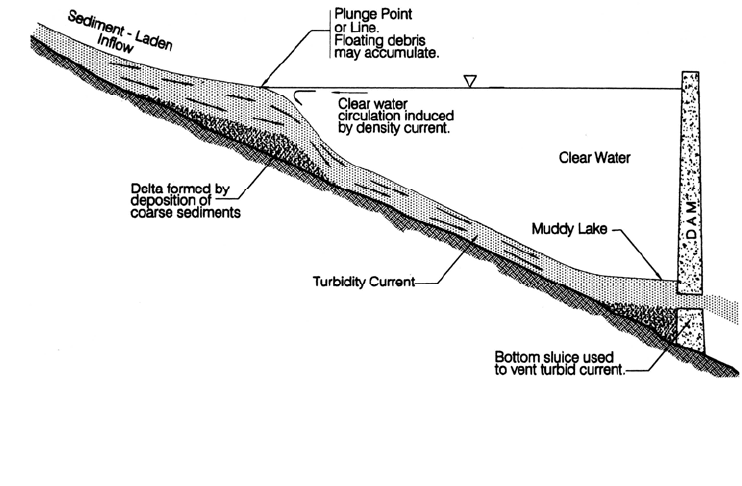
TURBID DENSITY CURRENTS 14.2
FIGURE 14.1 Schematic diagram of the passage of a turbid density current through a reservoir
and being vented through a low-level outlet.
current will dissipate along the way to the dam. If the current reaches the dam, it will
accumulate to form a submerged muddy lake, and the turbid water reaching the dam can
be vented if low-level outlets are opened. An idealized sketch of a turbidity current
passing through a reservoir is illustrated in Fig. 14.1, which shows the plunging flow,
passage along the bottom of the impoundment, accumulation as a submerged "muddy
lake" before the dam, and release through a low-level outlet. A turbidity current can be
sustained only as long as inflow continues; if the duration of the turbid inflow is less than
the travel time required to reach the dam, the current will dissipate.
Turbidity currents were first reported by Swiss scientists in the 1880s who observed
that turbid waters of the Rhine and Rhone Rivers plunged beneath the clear waters of
Lake Constance and Lake Geneva (Forel, 1885). An aerial photograph of the plunging
Rhone River is shown in Fig. 14.2. Plunging was attributed to both temperature and
turbidity differences, but it was recognized that the density difference due to turbidity
was the most important factor. This initiated the scientific study of density current
phenomena in lakes.
The earliest records of turbidity current releases from a reservoir were made in July
1919 at Elephant Butte Reservoir on the Rio Grande in the United States, where the
inflow suspended-sediment concentration was 72 g/L and discharge from the low-level
outlet at the dam was 41 g/L. Similar observations were made in 1921, 1923, 1927,
1929, 1931, 1933, and 1935 (Lane, 1954). The passage of turbid water through Lake
Mead during 1935-36 was described by Grover and Howard (1938), and numerous
subsequent turbidity current events were monitored by the U.S. Bureau of Reclamation
(1948). Under favorable conditions, turbidity currents can travel long distances in
reservoirs and be released through low-level outlets. Turbidity currents in Lake Mead
traveled for distances of 129 km to reach the dam, the longest recorded travel distance for a
reservoir turbidity current. In China, systematic measurements of turbidity currents
were made in Guanting Reservoir on the Yongding River near Beijing in the 1950s, and
at Sanmenxia Reservoir in the 1960s and at Luijiaxia Reservoir in the 1970s, both on
the Yellow River.
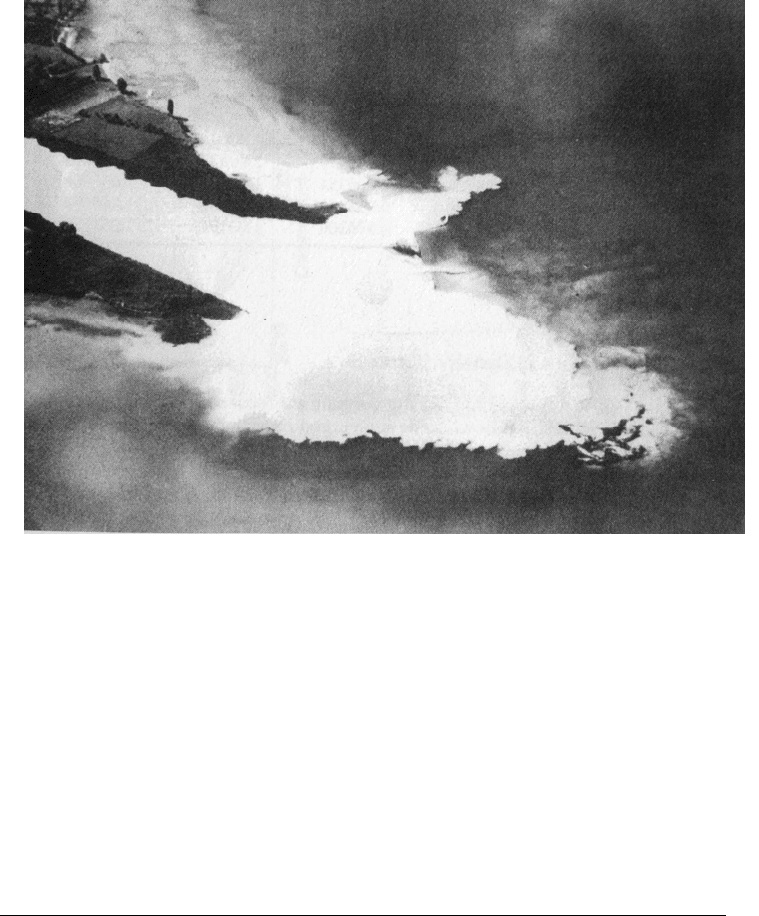
TURBID DENSITY CURRENTS 14.3
FIGURE 14.2 Aerial photograph of tur
b
id water from the Rhone plunging beneath the waters
of Lake Geneva (Swiss Federal Institute, Lausanne).
Bell (1942) suggested that turbidity currents could be vented from Lake Mead to
reduce the rate of reservoir sedimentation. Although Bell's suggestions were not
implemented at Lake Mead, at some reservoirs in Algeria and China over half the
inflowing sediment load from individual flood events has been passed through the
impoundment as a turbidity current and vented from the dam through low-level sluices.
At other sites with different sediment and geometric characteristics, turbidity currents do
not reach the dam and there is no opportunity for their release, but they continue to be
important in distributing sediment within the reservoir.
14.2 GENERAL CHARACTERISTICS
14.2.1 Variation in Density
Differences in both temperature and suspended solids contribute to stratification in
reservoirs. When inflowing water has a higher solids concentration and lower
temperature than impounded water, both turbidity and temperature will make the inflow
relatively more dense and cause it to plunge. Turbid water is often warm and will plunge
beneath colder water, since suspended solids can have a much greater influence on
density than temperature. Densities for several water and sediment mixtures are given in
Table 14.1, illustrating the large effect of suspended solids on density.

TURBID DENSITY CURRENTS 14.4
TABLE 14.1 Density of Water and Sediment Mixtures As a Function of Temperature
and Suspended Solids
Water +
sediment
Temperature,°C Pure water 1 g/L 10 g/L 100 g/L
0 0.999868 1.000491 1.006095 1.062137
4 1
.000000 1.000623 1.006226 1.062264
10 0.999728 1.000351 1.005955 1.062002
20 0.998232 0.998855 1.004465 1.060562
30 0.995676 0.996300 1.001919 1.058103
Source: Washburn (1928).
14.2.2 Configuration of Density Currents
Being a gravity-driven flow, turbid density currents are focused into the deepest part of
the cross section, generally following the submerged river thalweg. Isolines of
concentration and velocity measured in a turbidity current at Sanmenxia Reservoir
illustrating this effect are shown in Fig. 14.3. In reservoirs where trees were not removed
prior to impounding, turbid density currents may be further focused along stream channels by
the submerged floodplain forest (Ford and Johnson, 1983). Flood discharge, suspended-
sediment grain size, and concentration all vary over the duration of a flood.
Consequently, turbid density currents are unsteady with respect to discharge, sediment
concentration, grain size distribution, velocity, and thickness.
14.2.3 Plunging Flow
The zone where the inflowing turbid water entering a reservoir plunges beneath the clear
water, thereby producing stratified flow, is called the plunge point or plunge line. In a
narrow reservoir the plunging flow will form a line across the width of the reservoir; the
surface water will be turbid upstream of this line and clear downstream of this line.
However, when a sediment-laden flow discharges into a wide reach, the turbid surface
water may extend into the reservoir as an irregular tongue-like current which can shift
from one side of the impoundment to the other.
As nonstratified flow entering the reservoir moves toward the plunge line, the depth
increases and velocity decreases, and the maximum thickness of the turbid current
occurs at the plunge point. The transition from nonstratified to stratified flow is
illustrated in Fig. 14.4. Plunging flow establishes a weak countercurrent in the
overlying clear water just downstream of the plunge line, causing clear surface water to
travel upstream. Since both downstream-moving and upstream-moving currents
converge along the plunge line, floating debris carried by the flood typically
accumulates immediately downstream of the plunging flow, a readily observable indicator
of the plunging phenomena. Bell (1942) observed an accumulation of driftwood and
other floating debris in Lake Mead on May 3, 1940, so extensive that it created a floating
barrier completely blocking the canyon section of the reservoir between 137 and 145 km
above the dam. In Switzerland, during the winter when the colder turbid Rhone flows
into and plunges beneath surface waters of Lake Geneva, the plunge line is defined by a
zone of ice accumulation characterized by the sound of ice being grated together by the
countercurrent (de Cesare, 1995).
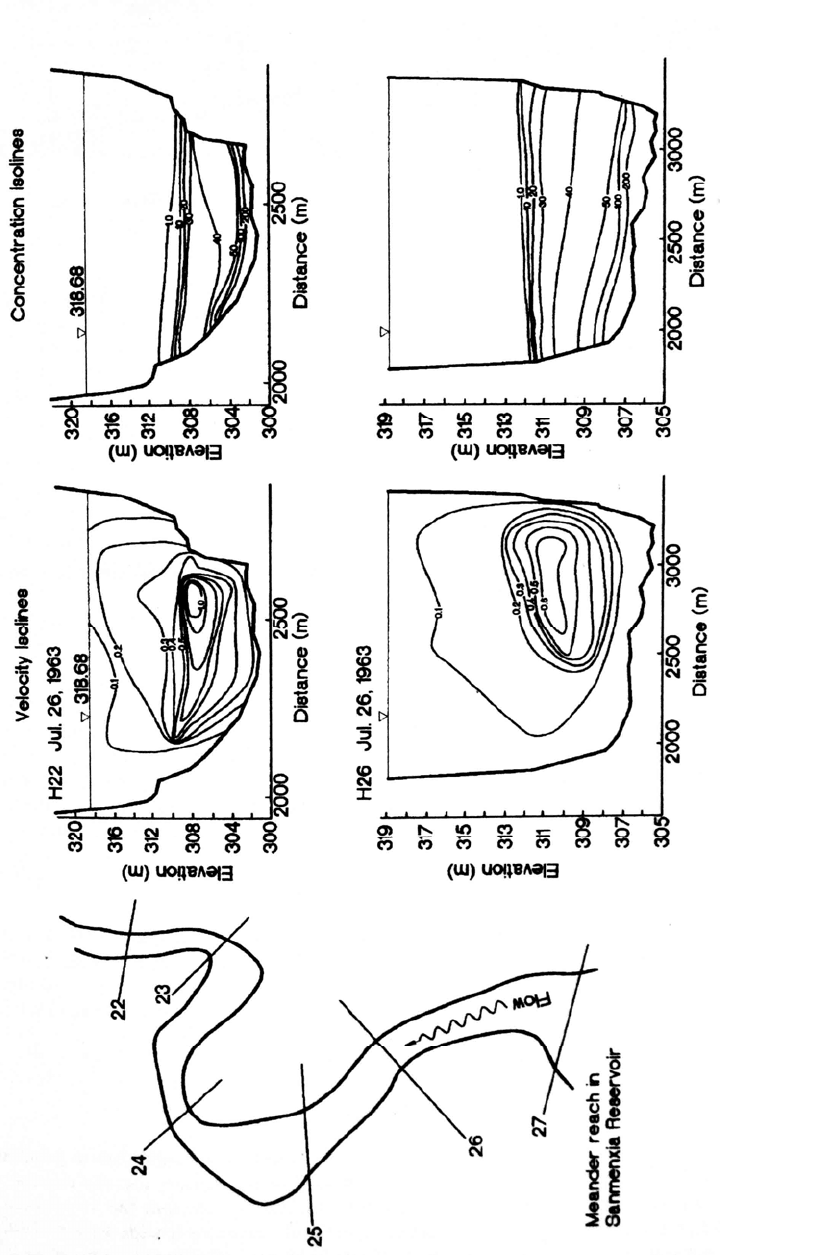
TURBID DENSITY CURRENTS 14.5
FIGURE 14.3 Isolines of velocity and concentration for a turbidity current passing through Sanmenxia Reservoir, China. Notice the
exaggerated vertical scale; the density current is actually about 6m thick and 500 m wide.
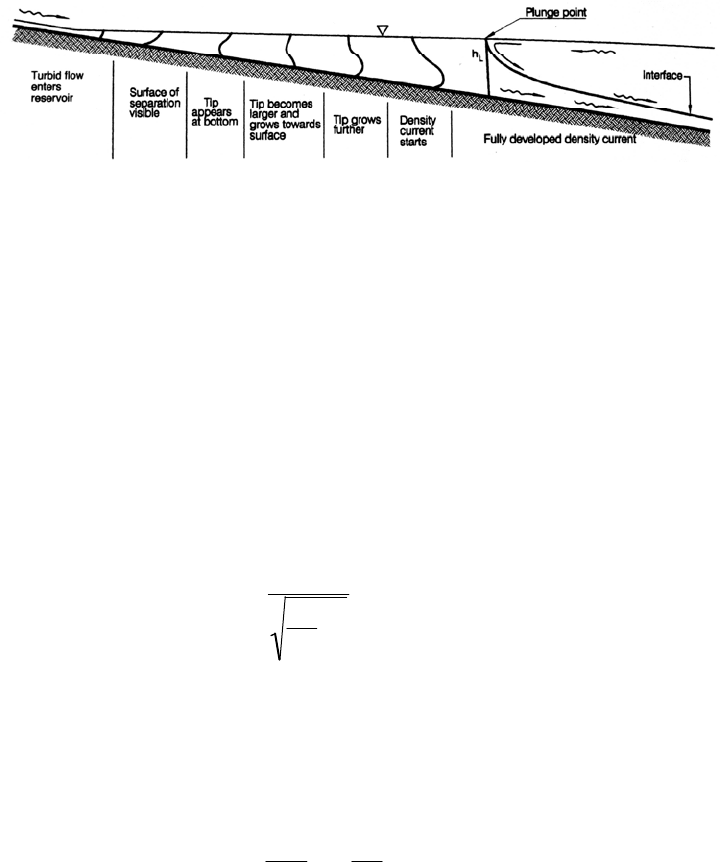
TURBID DENSITY CURRENTS 14.6
Figure 14.4 Transition from nonstratified to stratified flow (modified from Singh and Shan,
1971)
The plunge line is typically located at the downstream limit of the zone of delta
deposition, but its location is not fixed, being determined by pool level, discharge,
suspended sediment concentration, and reservoir geometry. Even if the water level
remains constant, the plunge point location can shift upstream and downstream a distance
of many kilometers during different parts of a flood as discharge and sediment
concentration vary. An increase in discharge or a decrease in sediment concentration
will cause the plunge point to move downstream into deeper water.
14.2.4 Plunge Point Location
The water depth at the plunge point can be estimated based on the densimetric Froude
number at the plunge point (F
p
):
F
p
V
gh
(14.1)
where V is the mean velocity, h is the water depth at the plunge point, ρ is the density of
the impounded clear water, is the density of the turbid water, and = . The
equation for the densimetric Froude number [Eq. 14.1)] can be rearranged to determine
the depth h at the plunge point by assuming a rectangular cross section with a bottom
width B and substituting the continuity equation in the form V = Q/Bh, to produce
h
Q
F
p
B
2/3
g
1/3
(14.2)
Both flume tests and measurements in reservoirs indicate that the densimetric Froude
number has a value of about 0.78 at the plunge point. Values of densimetric Froude
numbers reported by various researchers are summarized in Table 14.2. Several other
methods for computing the plunge point location were discussed by Ford and Johnson
(1983).
14.2.5 Turbidity Current Forward Motion
To travel long distances, the velocity of a turbid current must be sufficient to generate the
turbulence required to maintain its sediment load in suspension, thereby maintaining the
density difference between the gravity-induced current and the surrounding fluid.
When a turbidity current is initiated, it typically contains a wide range of suspended
particle sizes, including particles that cannot be maintained in suspension by the turbulence
within the current but which have not yet settled out of suspension. Settling of larger par-

TURBID DENSITY CURRENTS 14.7
TABLE 14.2 Densimetric Froude Number F
p
at Plunge Point
Author Laboratory or field data F
p
Bu et al., 1980 Liujiaxia reservoir, Tao River 0.78
Fan, 1991 Guanting Reservoir 0.5-0.78
Fan, 1960 Turbid water flume tests, 3-19 g/L 0.78
Cao et al., 1984 Turbid water flume tests:
10-30 g/L 0.55-0.75
100-360 g/L 0.4-0.2
Singh and Shan, 1971 Saline water 0.3-0.8
Farrel and Stephan, 1986 Cold water 0.67
ticles reduces fluid density and the gravitational forces which maintain the flow, causing
velocity to decrease. Lower velocity means less turbulent energy and less sediment-
carrying capacity, which induces additional settling and further reduces the gravitational
driving force and velocity. This process of sediment loss and velocity reduction continues
until motion stops. This same process also causes a longitudinal reduction in the grain
size of the suspended solids carried by the current and deposited along the bottom of the
reservoir; grain size decreases along the direction of turbidity current movement.
Turbidity current flow can be maintained over long distances only when it contains an
adequate concentration of slowly settling fine-grained sediment that can be maintained in
suspension by the current velocity.
A turbidity current having a potential travel distance greater than the length of a
reservoir may be passed through low-level outlets in the dam and released from the
impoundment. This requires that the flood have a duration exceeding the turbidity current
travel time between the plunge point and the dam, since the flow of a turbidity current is
maintained by the continued supply of sediment-laden water. When the inflow ceases,
the turbidity current will dissipate.
The transition from nonstratified to stratified flow and subsequent movement of a
turbidity current along Sanmenxia Reservoir is illustrated in Fig. 14.5. In this case the
current formed as sediment settled in the backwater reach, causing deeper flow to
accelerate in relation to the surface water, which continued moving downstream at a
lower velocity. At range R1 near the dam, the flow field is further distorted by the release
from low-level outlets at elevation 300 m, and the sediment concentration becomes hyper-
concentrated near the bottom. Particle size decreases regularly in the downstream
direction. Near the upstream area of Sanmenxia Reservoir, discharge from the
sediment-laden Wei River has also been observed to produce turbid underflows moving
both upstream and downstream beneath the current of the Yellow River. Conversely,
when the Yellow River has higher sediment concentration, it plunges and flows
upstream beneath the Wei River. Conditions in Sanmenxia Reservoir are discussed in
more detail in that case study (Chap. 24).
14.2.6 Turbidity Current Behavior at a Bend
Flume tests (Fan et al., 1959) revealed that the centrifugal forces at a bend cause the
turbidity current interface to rise at the exterior of the bend and decline at the interior of
the bend. Similar behavior has also been observed in Sanmenxia and Guanting
Reservoirs. The Yellow River has a meandering reach between Range H26 and H22 in
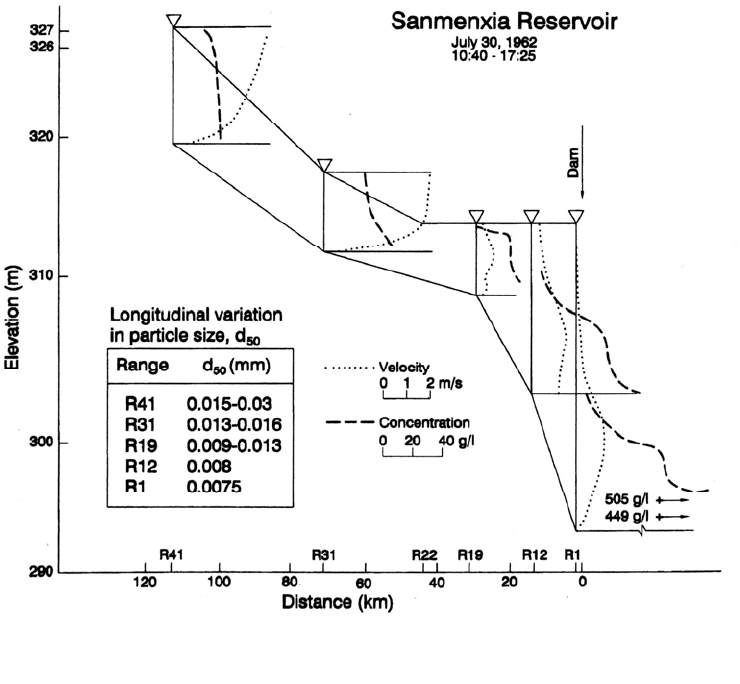
TURBID DENSITY CURRENTS 14.8
FIGURE 14.5 Passage of turbidity current through Sanmenxia Reservoir when held at a low pool
elevation.
Sanmenxia reservoir with radii of curvature between 1.3 and 2.8 km (Fig. 14.3). Field
measurements of velocity and concentration showed that the submerged current tended to
be focused on the outside of each meander bend. At sharper bends in Guanting Reservoir,
turbidity isolines were also elevated at the exterior of the bend.
14.2.7 Submerged Muddy Lake
When a turbidity current reaches a barrier such as a dam, the forward velocity is
converted into head and the current will rise up against the face of the barrier, and
subsequently fall back down to initiate formation of a muddy lake. When a turbid
density current reaching the dam is not vented, or is vented slowly, the accumulating
turbid water forms a submerged muddy lake having a sharp interface with the overlying
clear water. The surface of this muddy lake will extend along a nearly horizontal
profile upstream from the dam. The volume of the muddy lake will increase and the
interface will rise, as long as turbid inflow exceeds losses by (1) venting and (2) the
upward seepage of clear water from within the muddy lake due to sedimentation and
compaction of the solids. The muddy lake interface may suddenly rise in response to
fresh inflow and slowly fall due to hindered settling. The variation of the muddy lake
interface in Lake Mead over a 25-month period is shown in Fig. 14.6. Changes in density
with depth are also shown, illustrating the slow settling and compaction of the solids in
the submerged muddy lake. Muddy lake formation can also occur upstream of other
submerged obstacles such as a cofferdam.

TURBID DENSITY CURRENTS 14.9
Sedimentation within the muddy lake causes sediment concentration and fluid density
to increase with depth, and subsequent turbid inflows will spread across the top of the
higher density fluid in the muddy lake. The inflowing density current is thus converted
from underflow to interflow in areas affected by muddy lake accumulation. Interflow
conditions observed in Sanmenxia Reservoir are illustrated in Fig. 14.7. In this case, the
muddy lake was not formed by the main dam but by accumulation behind a landslide
deposit which acted as submerged barrier.
14.3 TURBIDITY CURRENTS AND SEDIMENT DEPOSITS
Turbidity currents reaching the dam create two types of sediment deposits. Thalweg
deposits due to sedimentation from the turbidity current extend downstream from the
plunge point and are formed by currents that reach the dam as well as those that dissipate.
Horizontal deposits of fine-grained material extending upstream from the dam can be
formed only by turbidity currents that reach the dam and create a muddy lake.
14.3.1 Thalweg Deposits
As turbid density currents travel along the thalweg, they deposit sediment that fills the
cross-section from the bottom up, first occupying submerged river channels, and when the
channel is filled it produces a relatively flat layer of deposits. Cross-section data from
reservoirs worldwide consistently show that most deposition is focused along the
thalweg, while sites a short distance away and only marginally shallower generally
receive little sediment deposition. This phenomenon is an indication that turbid density
currents are important mechanisms controlling the transport and deposition of fine-
grained sediment.
Sediment begins depositing from turbidity currents immediately downstream of the
plunge point and continues depositing until the current dissipates. These deposits are
typically thickest and contain the coarsest material near the plunge point, and both grain
size and deposit thickness decrease moving downstream. The resulting deposit may be
described as wedge-shaped, since it is thickest at the upstream limit and becomes
progressively thinner moving toward the dam. Deposits from turbidity currents consist of
material significantly finer than the delta deposits, even in reservoirs where most of the
inflowing load consists of fines. For example, at Guanting Reservoir most inflowing
sediment is silt (less than 0.062 mm). However, whereas the diameter of sediment
particles in the delta reach is usually greater than 0.03 mm, turbidity currents typically
carried sediments with d
90
diameters of 0.010 to 0.020 mm and deposited these finer
sediments downstream of the delta.
14.3.2 Muddy Lake Deposits
When turbid density currents reach the dam and form a muddy lake, a characteristic
deposition pattern is created which consists of sediment deposits extending nearly
horizontally upstream from the dam. One example of such deposits is shown in
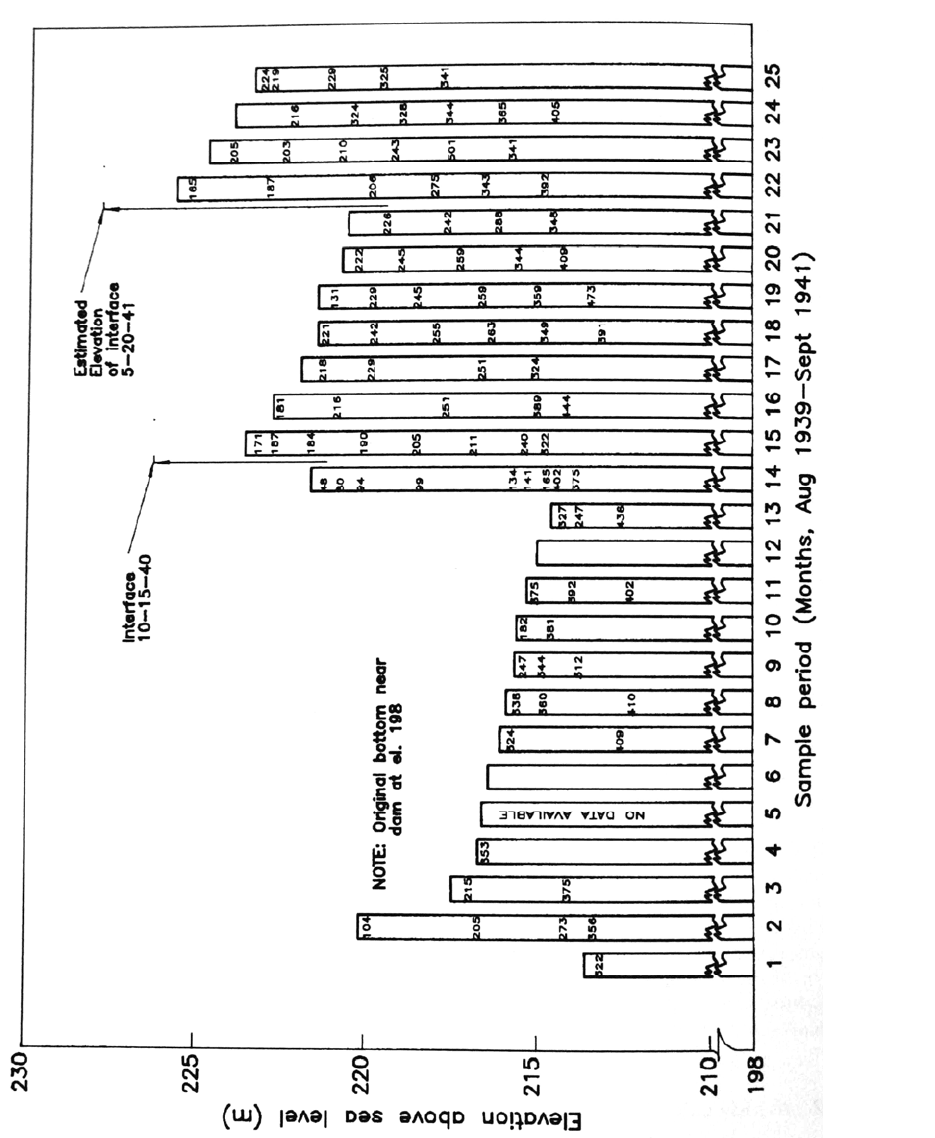
TURBID DENSITY CURRENTS 14.10
FIGURE 14.6 Dynamic behavior of the muddy lake in Lake Mead based on monthly measurements over a 2-year period. The
inflow of new turbidity current events causes the lake level to rise abruptly, and sedimentation causes the interface to settle
slowly. Sediment concentrations (g/L) are shown as a function of depth within the bars (adopted from Bell, 1942).
